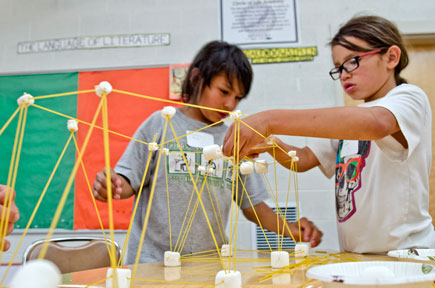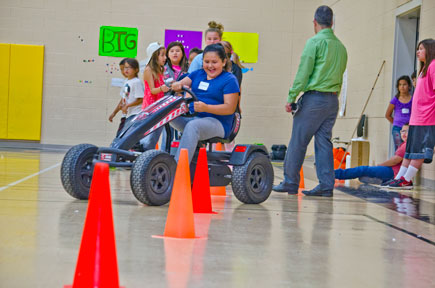-on lesson on bridge design.
In June, more than 40 White Earth Nation students were introduced to a variety of transportation topics in a daylong session offered by the Roadway Safety Institute (RSI).
The program was part of the White Earth Indian Reservation Summer Academy of Math and Science, a two-week day camp for reservation youth in grades 4 to 8. The camp focuses on hands-on learning and uses Indian culture and heritage as a vehicle for studying math, science, and engineering. It is offered in partnership by the White Earth Nation and the University of Minnesota Extension.
“This is a unique program that has been a great way to meet RSI’s objectives of teaching safety and building tribal partnerships,” says Colleen O’Connor Toberman, CTS/RSI program coordinator.
This year, staff led students through a variety of interactive activities to spark their interest in transportation, engineering, and safety.
In a lesson on road sign design, students learned about sign retroreflectivity, shape, and color before creating their own road signs using the Ojibwe names for local places. Another lesson introduced students to the essentials of bridge design and then allowed students to build their own bridges and test their stability and strength. Staff also tied engineering concepts to the camp’s emphasis on natural science in a lesson exploring how beavers modify their living environment with dams and bridges.
Students experienced the dangers of distraction by getting behind the wheel of pedal carts in a lesson co-taught by Minnesota Toward Zero Deaths program regional coordinator Tom Nixon. The lesson demonstrated how distractions and multitasking impair essential concentration while driving and walking. Nixon also engaged students in discussions about booster seats and seat belt use, sharing ideas to help students encourage their friends and relatives to buckle up.
“Just knowing how high the [roadway] death rate is in our reservation communities…anything we can incorporate into our curriculum to try and keep our young people safe is a very worthwhile part of the program,” says Deb Zak, regional director of the U of M Extension’s Northwest District.
Nixon hopes students will make safer driving choices in the future based on what they learned. “The great opportunity we had today was to talk to them before they become drivers,” he says. “We wanted them to learn about what their actions will lead to and the limitations of their abilities [when they’re distracted]. The more educated they are, the more aware they’ll be of what their choices will mean.”




